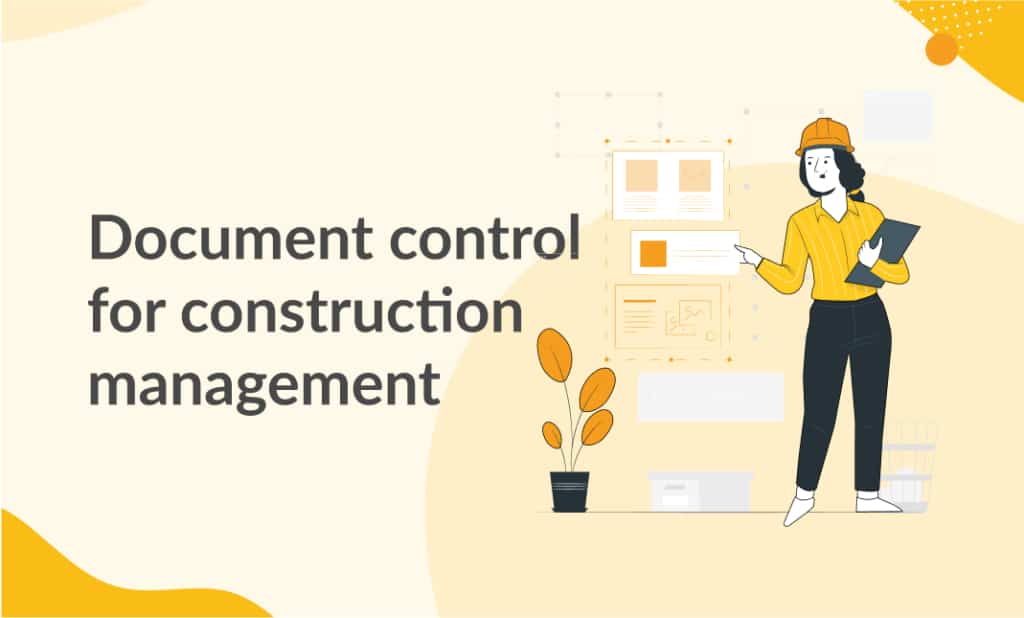Project management of any kind relies heavily on the smooth flow of technical documents, contracts, manuals, plans, designs, and any other similar documents.
Document control in construction management is all about creating a smooth workflow for all these documents to go between process owners and any stakeholders. It also dictates how the documents will be controlled throughout the lifetime of the project.
An ideal document control system for construction management should make it easy to manage, access, and share key project documents throughout your organization.
Going Digital with document control for construction management

We are all well aware that the days of storing documents in filing cabinets are long gone. This is because we don’t want the process held up waiting for a physical document to go from one end to another. We also don’t want to run into a situation where someone’s updates aren’t unanimously updated for everyone (which is impossible with a piece of paper).
Therefore, a cloud-based storage solution that allows for varied levels of access between users and user groups is ideal for this application. This level of connectivity also assures a smooth workflow and uninterrupted document control. The longer the project continues, the more documentation it accumulates, and greater the complexity grows.
However, if all users had pertinent access at runtime, regardless of device, connection, or location, then there would not be any complexity. You would only have transparency between processes and costly mistakes can be avoided.
You should be able to designate certain files or folders to certain users or user groups such that they have complete access to these files or folders, and another group (like stakeholders and investors) can have view-only access. That way people can update documents without any unwarranted interference. You can also have audit-trails that show which user accessed which file and when, helping ensure compliance.
Auto Update
The whole point of improving document workflow in project management is that it gives everyone easy access to documents as they are needed. Imagine a scenario where the architect and supervisor decide on a change in project. Instead of having to wait for a series of workflow modifications, in a cloud-based system, all they would have to do is to create the changes in a file and share it with the necessary decision makers. The decision makers and the team can go back and forth with their comments directly on the document as “comments”, when a final decision has been made, a series of approvals can be gained either all at once, or one by one. The entire process can take place on the same file without moving an inch.
This also helps ensure that everyone gets the information shared on time and in full.
This form of workflow improvement can be felt across the whole project. It will run smoothly, and all involved will have the latest information at all times.
Connecting site and office
There is no need for hyperbole when it comes to the importance of communication. Imagine the simplicity if you, when on site, are able to transmit invoice information from your iPad using a data sim, to the investor’s smartphone, or computer (Mac, Windows, or Linux), anywhere in the world using any functional web connection, you wouldn’t have to worry about wait times in between any changes or updates.
Security
The last thing anyone wants is to compromise a project’s security by allowing unauthorized access to any part of the process. That can be avoided when a document control system for construction management is kept secure behind a 256-bit bank-level encryption that would prevent even the most powerful supercomputer from getting into the system, even if it had a trillion years to try. Moreover, any communication in and out of the system is encrypted in SSL, ensuring that data is not tampered with mid-transition. All content is also backed up in triplicate (not counting any offline copies) ensuring that there is no need to worry about data loss.
Conclusion
Construction is one of the oldest businesses in the world, the presence of complex structures is one of the biggest indicators of an intelligent civilization no matter how far back we look in history. However, this industry has historically been slow to adapt to new technologies around the world.
This is because new technologies require training everyone from top to bottom and that might prove to be an expensive and time intensive undertaking. However, with a solution like Folderit that covers everything and then some, the award-winning UI makes it easy to pick up for anyone with even a basic understanding of computers.



